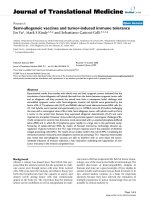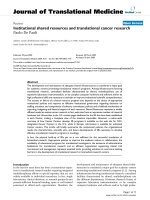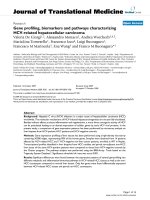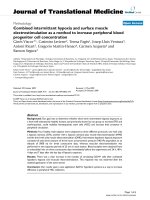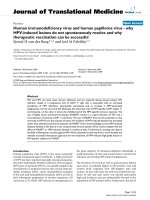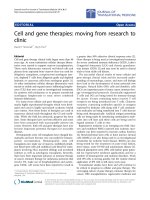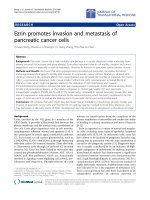Báo cáo hóa học: "Two novel low-power and high-speed dynamic carbon nanotube full-adder cells" pdf
Bạn đang xem bản rút gọn của tài liệu. Xem và tải ngay bản đầy đủ của tài liệu tại đây (1.26 MB, 7 trang )
NANO EXPRESS Open Access
Two novel low-power and high-speed dynamic
carbon nanotube full-adder cells
Mehdi Bagherizadeh
1*
and Mohammad Eshghi
2
Abstract
In this paper, two novel low-power and high-speed carbon nanotube full-adder cells in dynamic logic style are
presented. Carbon nanotube field-effect transistors (CNFETs) are efficient in designing a high performance circuit.
To design our full-adder cells, CNFETs with three different threshold voltages (low threshold, normal threshold, and
high thres hold) are used. First design generates SUM and COUT through separate transistors, and second design is
a multi-output dynamic full adder. Proposed full adders are simulated using HSPICE based on CNFET model with
0.9 V supply voltages. Simulation result shows that the proposed designs consume less power and have low
power-delay product compared to other CNFET-based full-adder cells.
Keywords: carbon nano tube transistor, dynamic full adder, low power, high speed
Introduction
Carbon nanotube field-effect tran sistors (CNFETs) are
one of the new devices for designing low-power and
high-performance circuits [1,2]. Scaling of complemen-
tary metal-oxide semiconductor (CMOS) technology to
the nano ranges has many limitations and leads to
increase the leakage currents, power dissipation, and
short-channel effects [1-3]. C NFET technology mitigates
these problems and these limitations of CMOS technol-
ogy. Carbon nanotubes (CNTs) are sheets of graphite
which formed into cylinders. A nanotube with one layer
of carbon atoms is single-wall carbon nanotube
(SWCNT), and a CNT with multiple layers o f carbon
atoms is multi-wall carbon nanotube (MWCNT).
SWCNT has the ability to act as a conductor (metal) and
as a semiconductor as well [2,4].
The threshold voltage of a CNFET depends to its size,
Equation 1:
V
th
=
√
3
3
aV
π
eD
CN
T
(1)
Where e is the unit electron charge, V
π
= 0.033 eV is
the carbon π-π bond energy, a = 2.49 Å (angstrom) is
the carbon to carbon atom distance, and D
CNT
is the
CNT diameter, Equation 2:
D
CNT
=
α
√
3
π
√
n
2
+m
2
+nm
(2)
In Equation 2, n and m arechiralityofCNTanda =
0.142 nm is the inter-atomic distance between each car-
bon atom and its neighbor [1,2,5].
As indicated in Equation 1, the threshold voltage of
CNFETs depends to the inverse of the diameter of
nanotube used as a channel. As a result, different tra n-
sistors with different turn on voltage can be implemen-
ted by changing diameter of CNT [1-3,6].
A full adder is one of the most significant parts of a
processor. In all the arithmetic operations such as divi-
sion, multiplication, and subtraction, full adders are
used as essential components. The full adder also is the
core element of complex arithmetic circuits. As a result,
increasing the performance of a full adder leads to
increase the performance of the whole system [4,6-15].
There are many implementations of full adders which
are implemented using metal-oxide-semiconductor field-
effect transistor (MOSFET) and CNFET technologies.
These full adders are in standard static logic and in
dynamic logic. Dynamic logic style has some advantages
compared to the static logic style. These advantages are
as follows: the number of transistors is low, these tran-
sistors do not have any static power consumption, the
speeds of switching are high, and the voltage levels are
full swing. Dynamic logic style has also disadvantage of
high switching activity [10].
* Correspondence:
1
Science and Research Branch of Islamic Azad University, Tehran, Iran
Full list of author information is available at the end of the article
Bagherizadeh and Eshghi Nanoscale Research Letters 2011, 6:519
/>© 201 1 Bagherizadeh and Eshghi; licensee Spr inger. This is an Open Access article distributed under the term s of the Creative
Commons Attribution License ( which permits unrestricted use, distribution, and
reprodu ction in any medium, provided the original work is properly cited.
In this paper, we present two novel carbon nanotube
full-adder cells in dynamic logic style. These proposed
full adders are simulated using HSPICE based on
CNFET model with 0.9 V supply voltage. Simulation
result shows that the proposed designs consume less
power and have low power-delay product (PDP) com-
pared t o other classical CMOS and CNFET-based full-
adder cells, presented in other papers.
The rest of this paper is organized as follows: “Literature
review on full-adder cells in MOSFET and CNFET
technologies” presents some full adders which are
designed using MOSFET and CNFET t echnologies. In
“Proposed full adder cell designs,” we introduce two novel
high-speed and low-power carbon nanotube full adders in
dynamic logic. “Simulation results and comparison” com-
pares the proposed designs with other designs. “Conclu-
sion” concludes the paper.
Literature review on full-adder cells in MOSFET and
CNFET technologies
There a re different implementations of full-adder cells
which have been proposed in many researches [4,6-15].
In this section, some of these full adders which are
implemented using MOSFET and CNFET technologies
are introduced.
The complementary CMOS (C-CMOS) full adder [7]
has 28 transistors and composed of p-channel MOS
(PMOS) transistors as a pull-up network an d n-cha nnel
MOS (NMOS) transistors as a pull-down network. The
voltage levels of this full adder are full swing, but the num-
ber of transistors of this full adder is high.
The complementary pass-transistor logic full adder [5]
has 32 transistors, and the speed of switching of this
design is high. It has full swing voltage levels. Transmis-
sion-gates CMOS full adder [12] has 20 transistors. It is
composed of a PMOS transistor and an NMOS transistor
in a parallel form. The multi-output dynamic full adder
[10] has 21 transistors, 15 transistors to product SUM and
COU
T
outputs, and 6 transistors to invert inputs. The
26T full-adder cell [12] is c omposed of 10 transistors t o
produce XOR and XN OR functions in the first stage and
Table 1 Truth table of a full adder
A B CIN COUT SUM
000 0 0
001 0 1
010 0 1
011 1 0
100 0 1
101 1 0
110 1 0
111 1 1
Table 2 Simplified truth table of a full adder
SIGMA COUT SUM
000
101
210
311
Figure 1 Primary schema for the proposed low power dynamic carbon nanotube full adder.
Bagherizadeh and Eshghi Nanoscale Research Letters 2011, 6:519
/>Page 2 of 7
16 transistors to create COUT and SUM outputs in the
second stage.
The carbon nanotube full adder which is implemented
by means o f majority function is presented in [6]. In
this design, a three-input majority function is used to
implement COUT and a five-input majority function is
used to implement SUM, as presented in Equation 3.
“Majority” function is an odd-inputs logic circuit that
performs as a majorit y voter to determi ne the output of
the circuit:
SUM = Majority
(
A, B, C, COUT, COUT
)
(3)
In [14], another carbon nanotube full adder based on
majority function is presented which is a low-voltage
and energy-efficien t design. This full adder is composed
of eight transistors and five capacitors.
A high-speed capacitor-inverter-based carbon nano-
tube full adder based on majority-not function is pre-
sented in [13]. To design this full adder, NAND and
NOR functions are used. The output SUM of this full
adder is implemented by Equation 4:
S
UM = Minorit
y
(
A, B, C, 2 ∗ NAND
(
A, B, C
)
,2∗NOR
(
A, B, C
)
)
(4)
The carbon nanotube full adder presented in [15] is
another majo rity function based with 14 transistors and
3 capacitors. To design this full adder, NAND and NOR
functions are also used.
Proposed full-adder cell designs
Our proposed full-adder cells are in dynamic logic style.
There are two phases in a dynamic logic, pre-charge
phase and evaluation phase. The pre-charge phase is
accrued when Clock = 0; otherwise, the circuit enters the
evaluation phase. A PMOS transistor connects the output
nodes to their Vdd, at pre-charge phase. To avoid i ncor-
rect functionality a nd charge sharing problem, all the
input values s hould be c hanged at pre- charge phase. In
our designs, three capacitors and CNFETs with three dif-
ferent threshold voltages, low threshold, normal thresh-
old, and high threshold, are used.
Proposed low-power dynamic carbon nanotube full adder
ThetruthtableofafulladderisshowninTable1.As
indicated in this table, SUM output is “ 1” if the sum of
three inputs (SIGMA) is equal to “1” or “3"; otherwise, it
is equal to “0.” COUT output is equal to “1” if SIGMA is
equal to “2” or “3"; otherwise it is equal to “0.” The sim-
plified truth table of a full adder is shown in Table 2.
Based on these tables, our full adder is de signed. Figure 1
shows primary schema for the proposed low-power
dynamic carbon nanotube full adder (first design).
In this design, the T1, T2, T3, and T4 transistors are
NMOS transistors with normal thre sholds. The NOR
and NAND gates contains an NMOS transistor with Vt
Figure 2 Final schema for the proposed low power dynamic carbon nanotube full adder.
Table 3 State of transistors at evaluation phase for
different values of SIGMA
SIGMA T1 T2 T3 TB SUM
COUT
0 Off Off On On “0” Unchanged ("1”)
1 Off Off Off On Unchanged ("1”) Unchanged ("1”)
2 On On Off On “0”“0”
3 On On Off Off Unchanged ("1”) “0”
Bagherizadeh and Eshghi Nanoscale Research Letters 2011, 6:519
/>Page 3 of 7
Figure 3 Primary schema for the proposed multi-output dynamic full adder.
Figure 4 Final schema for the proposed multi-output dynamic full adder.
Bagherizadeh and Eshghi Nanoscale Research Letters 2011, 6:519
/>Page 4 of 7
= vt and a PMOS with Vt = Vdd - vt. In a NOR gate,
when all of the three inputs (A, B, C) are “0,” this out-
put is equal to “1"; otherwise, in all of the other min-
terms, this output is equal to “ 0.” In a NAND gate,
when all of the inputs are “ 1,” this output is equal to
“0"; otherwise, in all of the other minterms, this output
is equal to “1.”
Figure 2 shows the final schema for the proposed low-
power dynamic carbon nanotube full adder. As shown
in this figure, to obtain more efficiency and enhancing
theproposeddesign,weeliminateNANDgateand
replace the NMOS T4 transistor with a PMOS transistor
(TB) with high threshold, Vt = 2.5v,where
v =
Vdd
3
.
When all of the inputs are “ 1,” this transistor is “off";
otherwise, it is “on.”
This design is evaluated in all minterms. When clock is
equal to “0,” the circuit enters the pre-charge phase. In
this phase, a P MOS transistor connects the SUM and
COU
T
outputs to their Vdd. At evaluation phase, clock is
equal to “1.” In this phase, when SIGMA is “0,” T3 tran-
sistor is “on,” and T1 transistor is “off,” as a result SUM
output is equal to “ 0” and
COU
T
output is unch anged
and it is equal to “1.” At this phase when SIGMA is “1,”
the T1, T2, and T3 transistors are “off.” As a result, both
outputs, SU M and
COU
T
, are unchanged and the y are
equal to “1.” When SIGMA is “2,” then th e T1, T2, and
TB transistors are “ on.” As a result, both outputs are
equal to “0.” When SIGMA is “3,” then T3 and T4 tran-
sistors are “ off.” As a result, SUM output is unchanged
and it is equal to “1” and
COU
T
output is equal to “ 0.”
Table 3 shows the state o f all transistors for different
values of SIGMA.
Proposed multi-output dynamic carbon nanotube full
adder
Second design is a multi-output dynamic carbon nano-
tube full-adder cell. To design this full adder, three
capacitors and nine CNFETs are used. The primary
schema of this full adder is shown in Figure 3. In this
design, two PMOS transistors are used to charge the
outputs (
COUT
, SUM) in pre-charge phase. In order
to create
COU
T
output, an NMOS normal threshold
transistor is used. This transistor, along with two other
transistors and a NOR gate, is used to create SUM
output.
Figure 3 shows that when SIGMA is “0,” then there is a
path that connects t he GND (= “0” )to
COU
T
.Toover-
come this problem, an NMOS transistor (TA) with low
threshold ( Vt = 0.5v) is a dded to the circuit. Figure 4
shows this modification and final design of this multi-
output dynamic full adder. In this circuit, when SIGMA
= “ 0” this transistor is off and leads to disconnect the
path from GND to
COUT
.
Simulation results and comparison
Through a computer simulation, we compare our pro-
posed full-adder cells to four other different exiting car-
bon nanotube designs [6,13-15]. HSPICE based on
Figure 5 Input and output signal for both proposed designs at
0.9 V supply voltage.
Bagherizadeh and Eshghi Nanoscale Research Letters 2011, 6:519
/>Page 5 of 7
CNFET model [16,17] is used to simulate these full-
adder cells. To compare these full adders, three criteria,
delay, power dissipation, and power-delay product
(PDP), are employed. The supply voltage is considered
0.9 V for all circuits. The delay is calculated from 50%
of voltage level of input to 50% of voltage level of out-
put. For being more realistic, we place buffers (two cas-
caded inverter) i n the two outputs. The frequency of
clock signal is 50 MHz. For both proposed full-adder
cells, the input and output signals at the 0.9 V supply
voltages are depicted in Figure 5.
The results of simulation for 0.9 V Vdd voltage are
shown in Table 4. From delay point of view, among the
existing full adders, the design in [15] is the fastest full
adder and the design in [13] is the slowest full a dder.
Proposed low power dynamic carbon nanotube full adder
is 46% slower than the design in [15], 1 2% slower tha n
the design in [6], 39% slower than the design in [14], and
21% faster than the design in [13]. Among the existing
full adders, the power consumption of our proposed low-
power dynamic carbon nanotube full adder is lowest, and
it is 48% less than the design in [15], 87% less than the
design in [14], 75% less than the design in [13], and 89%
less than the design in [6]. The PDP of the propo sed full
adder is 90% lower than the design in [6], 81% lower than
the design in [13], 82% lower than the design in [14], and
3% lower than the design in [15].
Proposed multi-output dynamic full adder is 7% slower
than the design in [6], 26% faster than the design in [13],
36% slower than the design in [14], and 43% slower than
the design in [15]. This proposed full adder consumes 91%
less power than the design in [6], 78% less than the design
in [13], 90% less than the design in [14], and 50% less than
the design in [15]. The PDP of our proposed multi-output
dynamic full a dder is 91% lower th an the design i n [6],
84% lower than the design in [ 13],85% lower than the
design in [14], and 15% lower than the design in [15].
Conclusion
In this paper, we proposed two novel low-power car-
bon nanotube dynamic full adders. Transistors with
tree different threshold voltages, by changing diameter
of CNT, were used to implement the proposed
dynamic full adders. In the first proposed full adder,
SUM and
COUT
were generated through separate
transistors. Second proposed full adder, however, was a
multi-output dynamic full adder. Simulat ion results
showed that both proposed designs had less power
consumption and low PDP, compared to the previous
CNFET designs. Tab le 4 shows comparison betwee n
the proposed full-adder designs and circuits proposed
in [6,13-15].
Author details
1
Science and Research Branch of Islamic Azad University, Tehran, Iran
2
Shahid Beheshti University, GC, Tehran, Iran
Authors’ contributions
MB designed and simulated the proposed circuit, as part of his Master of
Science thesis research. ME was the advisor in his thesis research and gave
the general idea in the research and also helped in critical drafting of
manuscript and presentation of the results.
Competing interests
The authors declare that they have no competing interests.
Received: 15 June 2011 Accepted: 2 September 2011
Published: 2 September 2011
References
1. Hashempour H, Lombardi F: Circuit-level modeling and detection of
metallic carbon nanotube defects in carbon nanotube FETs. DATE07
2007.
2. Lin Sh, Kim YB, Lombardi F, Lee YJ: A new SRAM cell design using
CNTFETs. IEEE ISOCC 2008.
3. Avouris P, Appenzeller J, Martel R, Wind S-J: Carbon nanotube electronics.
Proc of IEEE 2003, 1772:1784.
4. Abdolahzadegan Sh, Keshavarzian P, Navi K: MVL current mode circuit
design through carbon nanotube technology. European Journal of
Scientific Research 2010, 152:163.
5. Issam S, Khater A, Bellaouar A, Elmasry MI: Circuit techniques for CMOS
low power high performance multipliers. IEEE J Solid-State Circuit 31 1996,
1535:1544.
6. Navi K, Momeni A, Sharifi F, Keshavarzian P: Two novel ultra high speed
carbon nanotube full-adder cells. IEICE Electronics 2009, 1395:1401.
7. Zimmermann R, Fichtner W: Low-power logic styles: CMOS versus pass-
transistor logic. IEEE J Solid-State Circuits 1997, 1079:1090.
8. Weste N, Eshragian K: Principles of CMOS VLSI design: a system perspective
New York: Addison-Wesley; 1993.
9. Navi K, Foroutan V, Rahimi Azghadi M, Maeen M, Ebrahimpour M, Kaveh M,
Kavehei O: A novel low-power full-adder cell with new technique in
designing logical gates based on static CMOS inverter. Microelectronics
Journal 2009, 1441:1448.
10. Mirzaee RF, Moaiyeri MH, Navi K: High speed NP-CMOS and multi-output
dynamic full adder cells. International Journal of Electrical, Computer, and
Systems Engineering 2010, 4:4.
Table 4 Comparison between the proposed designs and others CNT full adders
Full adders Parameters
Delay (pS) Power (μW) PDP × E-17 (SW)
Design in [6] 78.3 1.05 8.20
Design in [13] 114 0.332 3.80
Design in [14] 53.6 0.783 4.20
Design in [15] 47.8 0.129 0.618
Proposed low-power dynamic CNT full adder 89.3 0.067 0.596
Proposed multi-output dynamic CNT full adder 84.3 0.062 0.519
Bagherizadeh and Eshghi Nanoscale Research Letters 2011, 6:519
/>Page 6 of 7
11. Navi K, Moayeri MH, Mirzaeei RF, Hashempour O, Nezhad BM: Two new
low-power full adders based on majority not gates. Microelectronics
Journal 2009, 126:130.
12. Chang CH, Gu J, Zhang M: A review of 0.18 μm full adder performances
for tree structured arithmetic circuits. IEEE Transactions on Very Large Scale
Integration (VLSI) Systems 2005, 686:695.
13. Navi K, Rashtian M, Hashemipour O, Khatir A, Keshavarzian P: High speed
capacitor-inverter based carbon nanotube full adder. Nanoscale Research
Letters 2010, 859:862.
14. Navi K, Rad RSh, Moaiyeri MH, Momeni A: A low-voltage and energy-
efficient full adder cell based on carbon nanotube technology. Nano
Micro Letters 2010, 114:120.
15. Khatir A, Abdolahzadegan Sh, Mahmoudi I: High speed multiple valued
logic full adder using carbon nano tube field effect transistor. VLSICS
2011.
16. Deng J, Wong H-SP: A compact SPICE model for carbon-nanotube field-
effect transistors including nonidealities and its application - part I:
model of the intrinsic channel region. IEEE Trans 2007, 3186:3194.
17. Deng J, Wong H-SP: A compact model for carbon nanotube field-effect
transistors including nonidealities and its application - part II: full device
model and circuit performance benchmarking. IEEE Trans 2007,
3195:3205.
doi:10.1186/1556-276X-6-519
Cite this article as: Bagherizadeh and Eshghi: Two novel low-power and
high-speed dynamic carbon nanotube full-adder cells. Nanoscale
Research Letters 2011 6:519.
Submit your manuscript to a
journal and benefi t from:
7 Convenient online submission
7 Rigorous peer review
7 Immediate publication on acceptance
7 Open access: articles freely available online
7 High visibility within the fi eld
7 Retaining the copyright to your article
Submit your next manuscript at 7 springeropen.com
Bagherizadeh and Eshghi Nanoscale Research Letters 2011, 6:519
/>Page 7 of 7
